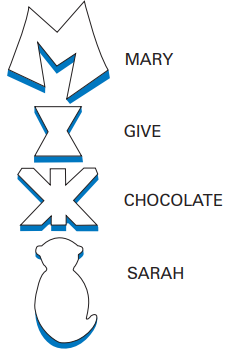
Sarah and Lana
 المؤلف:
George Yule
المؤلف:
George Yule
 المصدر:
The study of language
المصدر:
The study of language
 الجزء والصفحة:
2-17
الجزء والصفحة:
2-17
 8-1-2022
8-1-2022
 3715
3715
At the same time as Washoe was learning sign language, another chimpanzee was being taught (by Ann and David Premack) to use a set of plastic shapes for the purpose of communicating with humans. These plastic shapes represented “words” that could be arranged in sequence to build “sentences” (Sarah preferred a vertical order). The basic approach was quite different from that of the Gardners. Sarah was systematically trained to associate these shapes with objects or actions. She remained an animal in a cage, being trained with food rewards to manipulate a set of symbols. Once she had learned to use a large number of these plastic shapes, Sarah was capable of getting an apple by selecting the correct plastic shape (a blue triangle) from a large array. Notice that this symbol is arbitrary since it would be hard to argue for any natural connection between an apple and a blue plastic triangle.

Sarah was also capable of producing “sentences” such as Mary give chocolate Sarah and had the impressive capacity to understand complex structures such as If Sarah put red on green, Mary give Sarah chocolate. Sarah got the chocolate.
A similar training technique with another artificial language was used (by Duane Rumbaugh) to train a chimpanzee called Lana. The language she learned was called Yerkish and consisted of a set of symbols on a large keyboard linked to a computer. When Lana wanted some water, she had to press four symbols, in the correct sequence, to produce the message please machine give water.

Both Sarah and Lana demonstrated an ability to use what look like word symbols and basic structures in ways that superficially resemble the use of language. There is, however, a lot of skepticism regarding these apparent linguistic skills. It has been pointed out that when Lana used the symbol for “please” she did not have to understand the meaning of the English word please. The symbol for “please” on the computer keyboard might simply be the equivalent of a button on a vending machine and, so the argument goes, we could learn to operate vending machines without necessarily knowing language. This is only one of the many arguments that have been presented against the idea that the use of signs and symbols by these chimpanzees is similar to the use of language.
 الاكثر قراءة في Linguistics fields
الاكثر قراءة في Linguistics fields
 اخر الاخبار
اخر الاخبار
اخبار العتبة العباسية المقدسة


